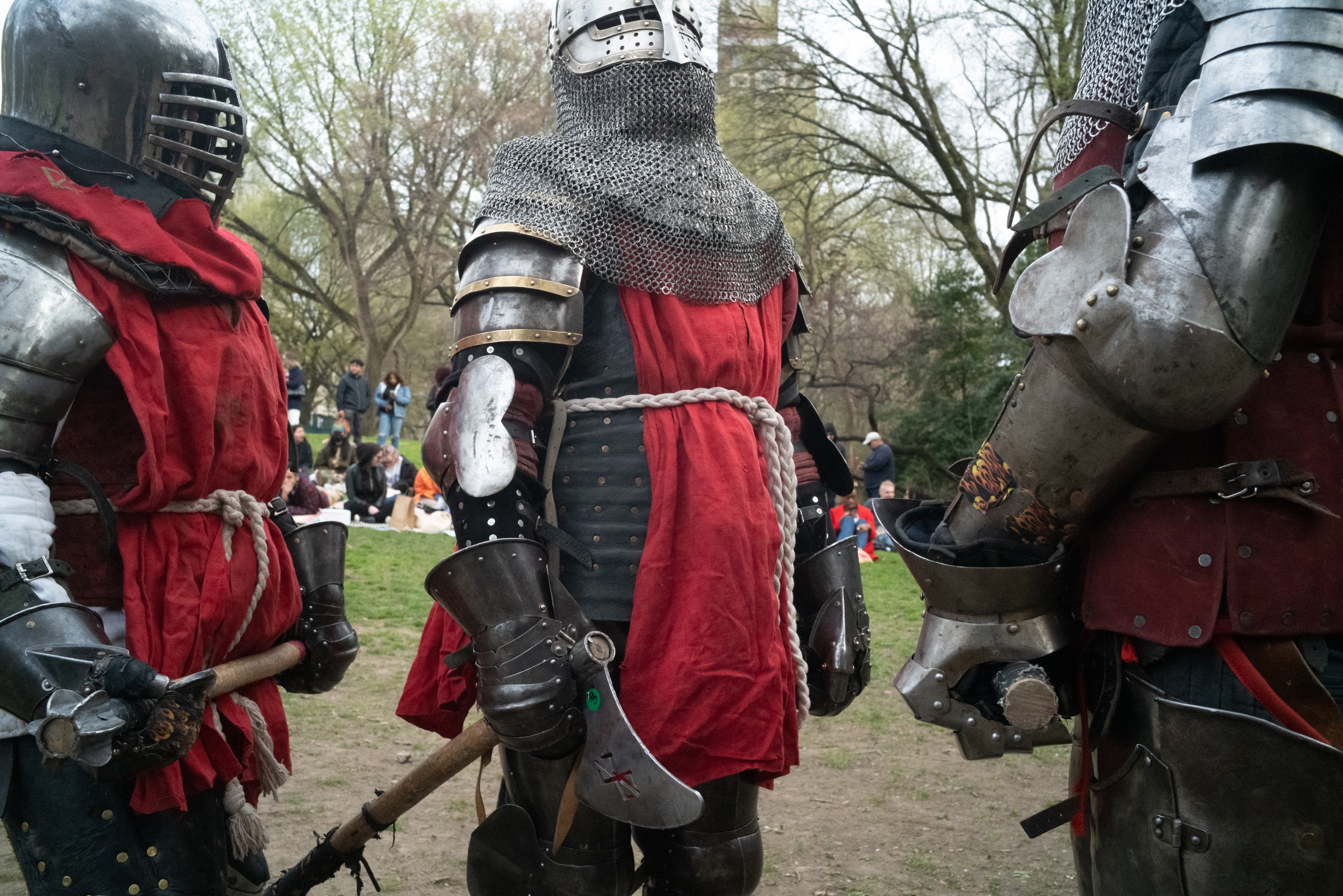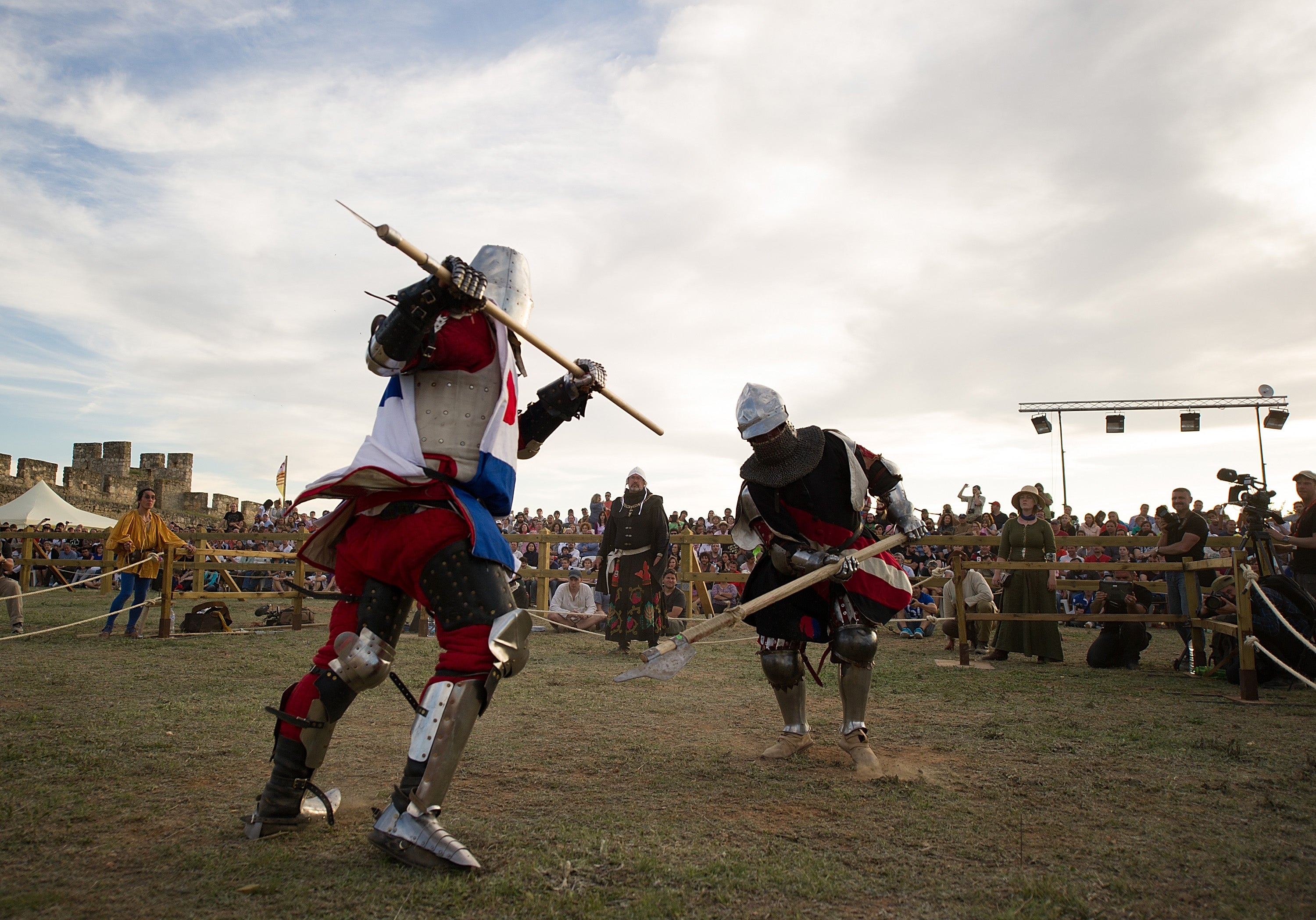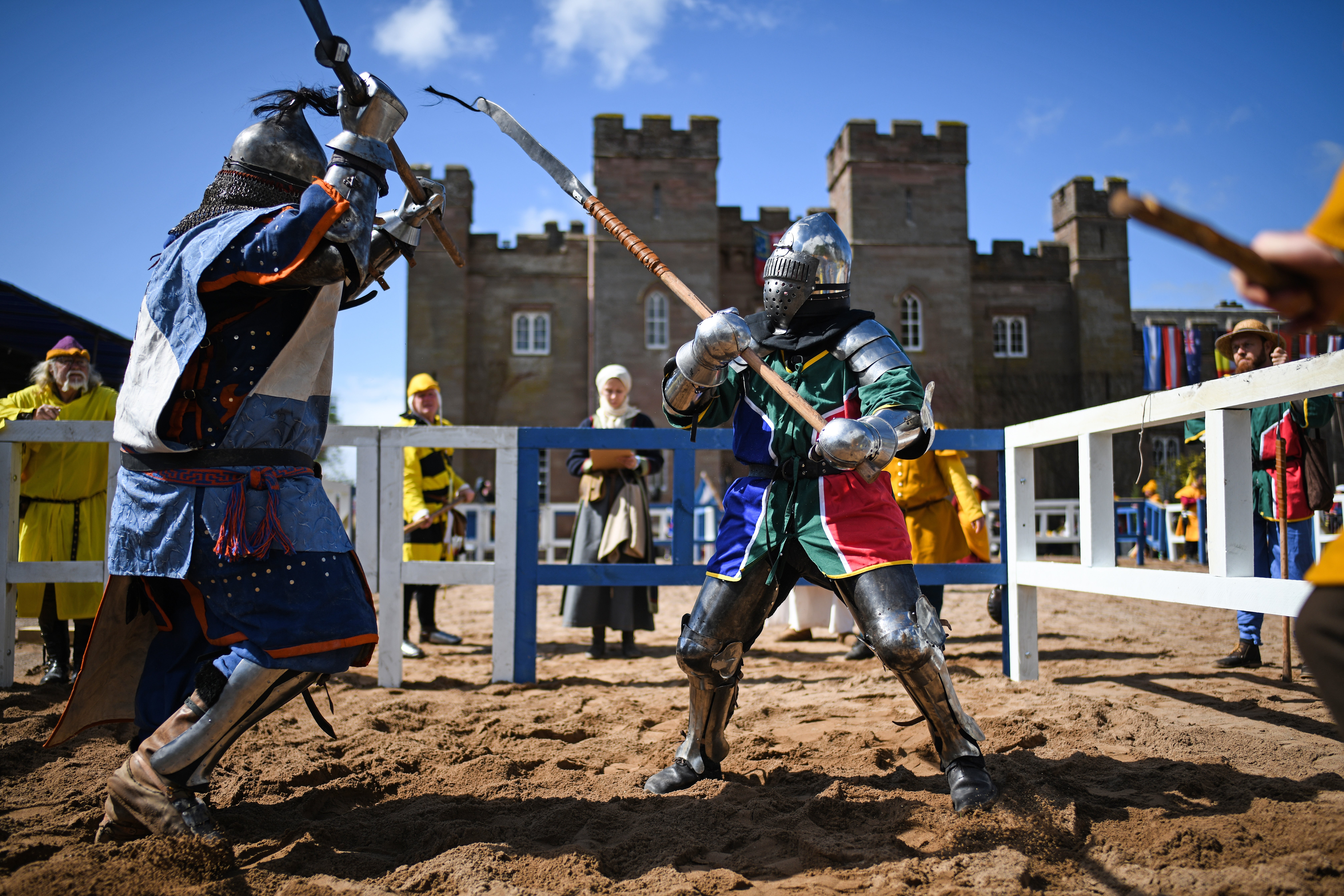Let battle commence: The modern-day knights in shining armour
Medieval armoured combat is a sport growing in popularity around the world. So what makes people want to don a tin can and get walloped with an axe? Kristen Hartke finds out

Even in New York, a city where pretty much anything goes, the sight and sound of knights in shining armour swinging swords at each other still draws a crowd.
“Are you ready for a medieval rumble?” shouts an announcer in a black kilt and leather boots. Spectators scream back and play begins, steel striking steel hard, combatants hitting the ground with loud thuds.
The scene is no scripted historical reenactment, though it takes place just outside the Metropolitan Museum of Art and the centuries of metal suits on display there. These knights are real rivals, clad head to toe for contests that have adapted ancient rules of engagement for modern-day action.
Today’s sport began a few decades ago in Eastern Europe, and now medieval armoured combat is spreading globally – including in the United States. There are training regimens for endurance. Teams and leagues for men and women. National federations as well as international competitions with prize money. Even two different world championships, recently held in Spain and the Czech Republic.

“It’s like full-contact MMA with steel weapons,” says 42-year-old Damion DiGrazia, who runs the team known as Gladiators NYC. “It’s also this sport that is surprisingly transformative for a lot of people.”
Participants describe finding emotional strength they never knew they possessed. They also stress the physical stamina required when donning 50 to 100 pounds of metal and then moving nimbly yet aggressively for matches that take place in every kind of weather.
“Putting yourself in a tin can doesn’t seem like it would be the epitome of the human condition,” says Megan Ganley, 26, captain of the women’s team for Iron Lions United in the Washington, DC, metropolitan area. “But it becomes a zen comfort as you begin pushing your limits and embracing the intensity.”
Take an athlete who wears themselves out in five minutes, mostly naked because they are just wearing shorts, then put them in armour. They won’t last more than one minute
Medieval armoured combat – or buhurt, from the Old French word béhourd, meaning “to wallop” – traces its history back more than a thousand years to feudal Europe, where knights would take part in peacetime clashes to stay in shape and test their skills. Today’s contests may showcase one-on-one sword fighting, with points awarded based on where blows land, or no-holds-barred melees between two teams – sometimes involving 30 or more players – in which the last person left standing is the winner.
Rounds typically last just a few minutes, with one minute of rest in between, so that players don’t run out of steam.
As the sport has taken root in the United States, it has attracted a range of fans, from self-described medieval history nerds to martial arts enthusiasts.
“The people who tend to stick with the sport are the high school athletes who played Dungeons & Dragons with their friends,” says Brennon Meiners, 41, captain of the Dallas Warlords and a 2019 national gold medalist in sword and buckler – a category in which a one-handed sword is used in combination with a small shield, or buckler, to deflect and punch.
As a teen, Meiners had gotten into role-play combat. He then switched to a type of martial art fighting that features rattan sticks. A video about armoured fighting inspired him to try something new several years ago. “I saw that video and thought, ‘I totally want to get hit in the face with an axe,’” he laughs.

The face is actually protected by a full steel helmet, albeit one weighing 10 pounds and lined with anti-concussion foam. Players say they barely feel the impact of the blunted weapons against their armour because they’re focused on simply staying upright.
“The fatigue level in armour is a ratio of one-to-five,” says Zorikh Lequidre, 54, one of the sport’s first American competitors and now a trainer, coach and announcer for Gladiators NYC events. “Take an athlete who wears themselves out in five minutes, mostly naked because they are just wearing shorts, then put them in armour. They won’t last more than one minute.”
Yet the allure of armour has attracted an increasingly diverse group of participants across race, gender and sexual identity lines.
When you’re out there fighting, no one can tell who is inside that armour. Then you take off your helmet, and you’ve got little Black kids asking if they can be knights, too
“The sport is historically white and male,” says D’Ondre Cyrus, the 36-year-old president of the American Medieval Combat Federation, “but we understand that representation matters.”
Cyrus is a member of the Dallas Warlords as well as the Knights of Wakanda, an African American team of about 20 that pulls from across the country and comes together for events. “When you’re out there fighting,” he says, “no one can tell who is inside that armour. Then you take off your helmet, and you’ve got little Black kids asking if they can be knights, too.”
More women are suiting up, too. “It’s a classically masculine space,” Ganley says, “but it’s also a sport still in its infancy, so it allows women and nonbinary people a place to discover the kind of person you want to be within it. I had a queer reckoning of my own that was just really fulfilled by the sport.”
Brooke Sileikis, 28, found a passion and a profession when she got involved with a local New Jersey team during the pandemic. She then started the New Jersey Steel Fighting Academy this year with her husband as a positive and safe place for people to train. They have about 22 members in practice twice a week.
“I like to be a girly girl, but I also like to roll around in the mud and hit people with weapons,” Sileikis says. “I experienced a lot of sexism when I first started in the sport, so I wanted to reframe that negative experience. Medieval armoured combat is an escape for a lot of people, a way to heal from past traumas.”

It’s a common story, one that resonates with 35-year-old Orlando Mendez. He was reeling from a bad break-up a decade ago when he decided to visit a Renaissance fair.
“I always wanted to be a knight and play with swords and wear armour,” he says, “and I see this one knight run across the field so fast and throw down this guy twice his size, and I was fascinated by it. A year later, I was one of the fighters on the field, not a spectator, and I won every fight. My family was there screaming, and I thought, ‘This is what I want.’ And I never looked back.”
Now you’ll find Mendez with Gladiators NYC in Central Park and at matches across the country, intent on outwitting his opponents while still cheering them on if they get the best of him.
“We’re getting people into armour and building a community,” he says. “It’s really incredibly cool.”
© The Washington Post






Join our commenting forum
Join thought-provoking conversations, follow other Independent readers and see their replies
Comments